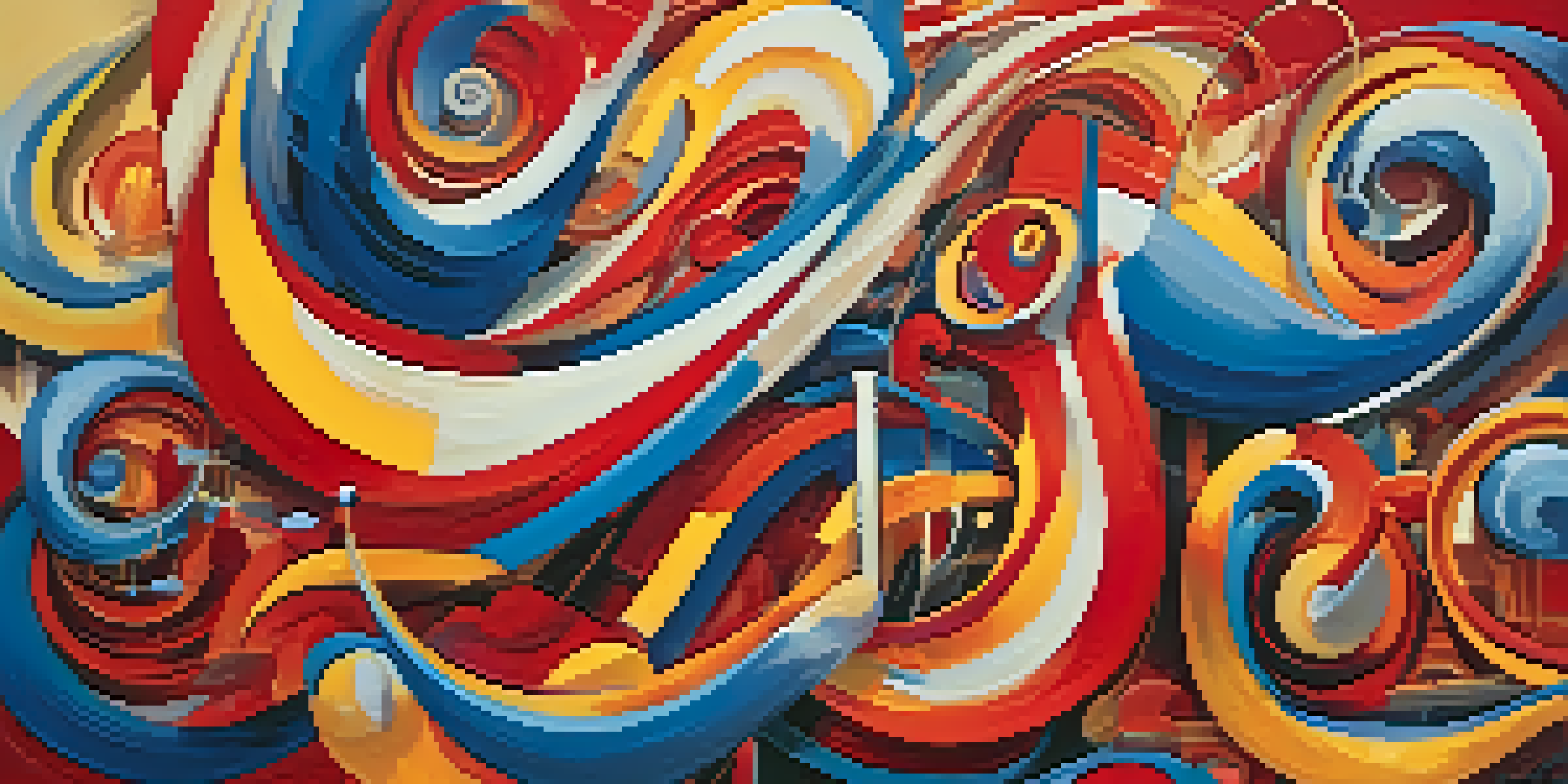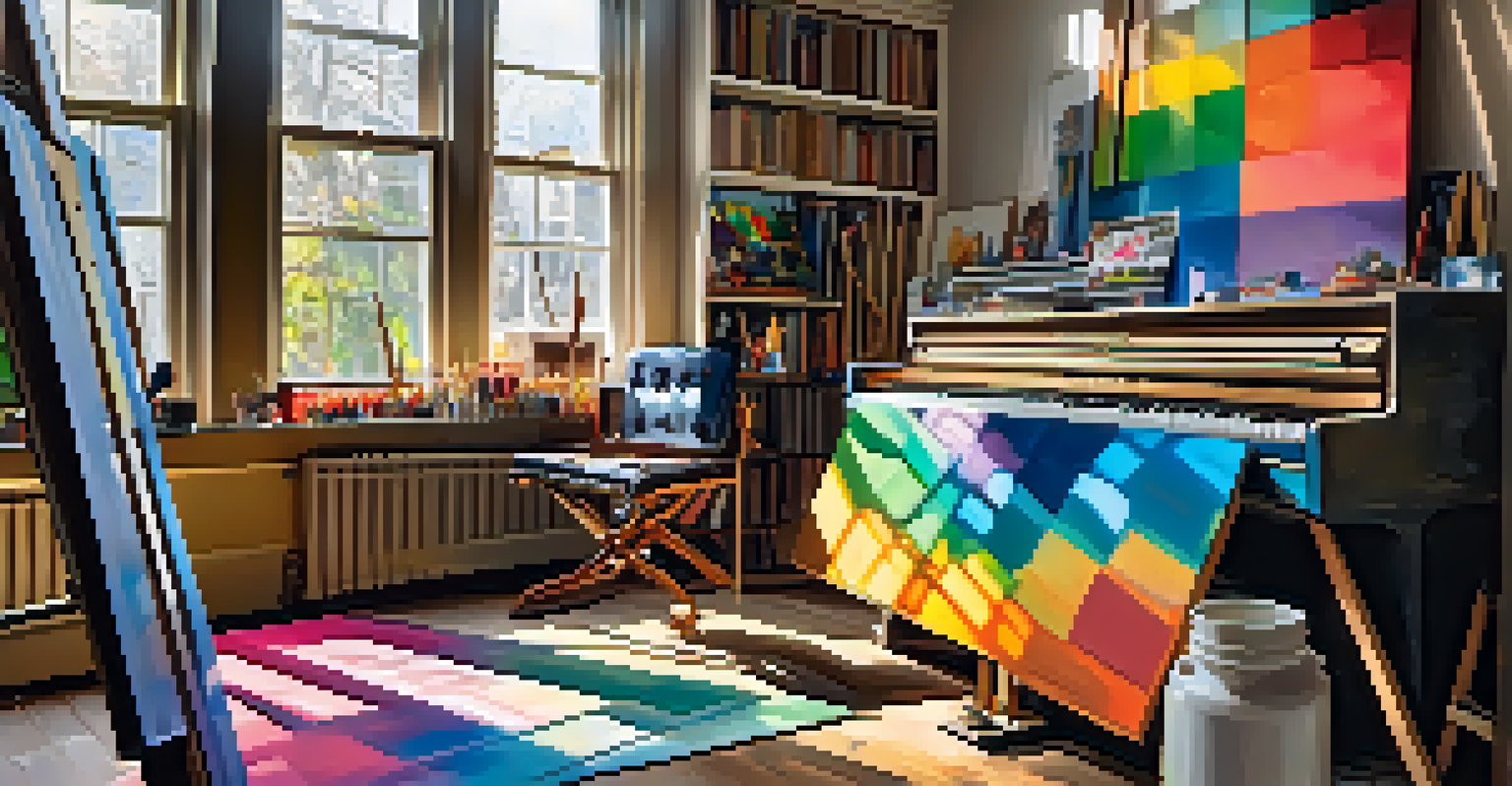Synesthesia: Experiencing Music Through Visual Art Forms

What is Synesthesia and How Does It Work?
Synesthesia is a fascinating neurological phenomenon where stimulation of one sensory pathway leads to automatic experiences in another. For example, someone might hear music and simultaneously see colors or shapes. This blending of senses can create a rich tapestry of experiences, making synesthetes feel as though they are living in a world full of vibrant connections.
Synesthesia is a condition in which stimulation of one sensory pathway leads to automatic experiences in a second sensory pathway.
While the exact cause of synesthesia isn't fully understood, it's thought to involve cross-wiring in the brain. This means that certain areas of the brain that process different senses may communicate more than they typically would. This unique wiring allows synesthetes to experience the world in a way that most people cannot, adding a layer of depth to their perception.
Synesthesia can manifest in various forms, such as grapheme-color synesthesia, where letters or numbers are associated with specific colors. Another type involves sound-color synesthesia, where different musical notes elicit visual experiences. Each person's experience is distinct, making the study of synesthesia both complex and intriguing.
The Relationship Between Music and Visual Art
Music and visual art have shared a symbiotic relationship for centuries. Artists often draw inspiration from music, while musicians may find their creative flow influenced by visual art. This interplay between the two forms of expression can create immersive experiences that captivate audiences on multiple levels.

When we consider how sound can evoke images, it becomes clear that music transcends auditory boundaries. For many, listening to a symphony may conjure up vivid landscapes or emotional scenes, enhancing the overall experience. This connection can be particularly pronounced for synesthetes, who may perceive these associations in tangible forms.
Understanding Synesthesia's Impact
Synesthesia blends sensory experiences, allowing individuals to perceive the world uniquely, often linking music with colors or shapes.
Visual art can also serve as a powerful medium for interpreting music. Artists may create pieces that reflect the rhythm, mood, or themes of a musical composition, allowing viewers to experience sound through sight. This merging of disciplines enriches both art forms and invites broader interpretations from audiences.
Famous Synesthetes and Their Art
Throughout history, many renowned artists and musicians have identified as synesthetes, using their unique perceptions to fuel their creativity. One notable example is the composer Franz Liszt, who reportedly experienced colors while playing the piano. His ability to translate these vivid sensations into music has left a lasting impact on classical compositions.
The more we explore the connections between the senses, the more we uncover the richness of human experience.
Another famous synesthete is the artist Wassily Kandinsky, who believed that colors and sounds were interconnected. Kandinsky's paintings often reflect this belief, with vibrant hues and dynamic forms that evoke musical qualities. His work continues to inspire artists and musicians alike, illustrating the profound influence of synesthesia on creative expression.
These examples highlight how synesthesia can offer a unique lens through which artists perceive and interpret their surroundings. By harnessing their sensory experiences, these individuals have contributed to the richness of both music and visual art, showcasing the beauty of interconnectivity in creativity.
How Synesthesia Influences Artistic Expression
For synesthetes, the experience of creating art can be a deeply immersive journey. As they engage with music, their minds may conjure vivid images that guide their artistic process. This unique relationship allows them to produce works that resonate with both auditory and visual dimensions, creating a multi-sensory experience for their audience.
Art created under the influence of synesthesia often showcases bold colors and dynamic forms, reflecting the intensity of the perceived sounds. This can result in pieces that are not only visually striking but also imbued with emotion and rhythm. The interplay between sound and sight in these artworks invites viewers to explore their own sensory perceptions.
Art and Music's Creative Connection
The relationship between music and visual art enables artists and musicians to inspire each other, creating immersive experiences that engage multiple senses.
Moreover, this blending of senses can serve as a bridge between different artistic communities. Musicians and visual artists may collaborate to create multimedia experiences that enhance performances and exhibitions. These partnerships foster innovation and expand the boundaries of traditional art forms, allowing for new and exciting expressions.
The Science Behind Synesthesia and Creativity
The connection between synesthesia and creativity has intrigued scientists and artists alike. Research suggests that synesthetes may possess heightened cognitive abilities, enabling them to think more broadly across disciplines. This unique cognitive processing can lead to innovative thinking, as they draw connections that others might overlook.
Studies have shown that synesthetes often excel in fields that require strong visual or auditory skills, such as music composition or visual arts. This may be due to their enhanced ability to integrate sensory information, allowing them to approach problems from unconventional angles. As a result, their creativity is often marked by originality and depth.
Understanding the science behind synesthesia can also shed light on how we all might harness our own creative potential. By exploring the connections between our senses, we can discover new ways to express ourselves and enrich our artistic endeavors. This exploration encourages a broader appreciation for the diverse ways in which creativity can manifest.
Exploring Synesthesia in Modern Art and Music
In today's world, synesthesia continues to inspire contemporary artists and musicians. Many creators actively seek to explore the interplay between sound and visual art in their work. This exploration often results in innovative projects that challenge traditional boundaries and invite audiences to engage with their senses in new ways.
For instance, some musicians have collaborated with visual artists to produce live performances that incorporate multimedia elements. These performances may include visual projections that respond to the music, creating an immersive environment where sound and sight are intricately intertwined. This approach transforms the audience's experience, allowing them to feel the rhythm in both their ears and their eyes.
Exploring Personal Creativity
While true synesthesia is neurological, anyone can enhance their creativity by engaging their senses through music and visual art.
Moreover, modern technology has further expanded the possibilities for exploring synesthesia. Virtual reality experiences and interactive art installations allow participants to engage with music and visual art in dynamic ways. These advancements invite people to not only observe but also participate in the creative process, deepening their connection to the art.
How to Experience Synesthesia Yourself
While true synesthesia is a neurological condition, there are ways for anyone to explore and stimulate their senses creatively. Engaging with music through visual art can be a great starting point. Try listening to your favorite song while painting or drawing what you feel; let the sounds guide your hand and see what emerges.
Another method is to play with color associations. Choose a color that represents a specific emotion or sound and create a piece of art based on that. This exercise encourages you to connect your sensory experiences, allowing you to tap into your creativity in a personal way.

Finally, don't hesitate to collaborate with others. Sharing creative experiences with friends or fellow artists can lead to new insights and interpretations. By discussing how music affects your perceptions, you may discover fresh perspectives that inspire your own artistic journey.